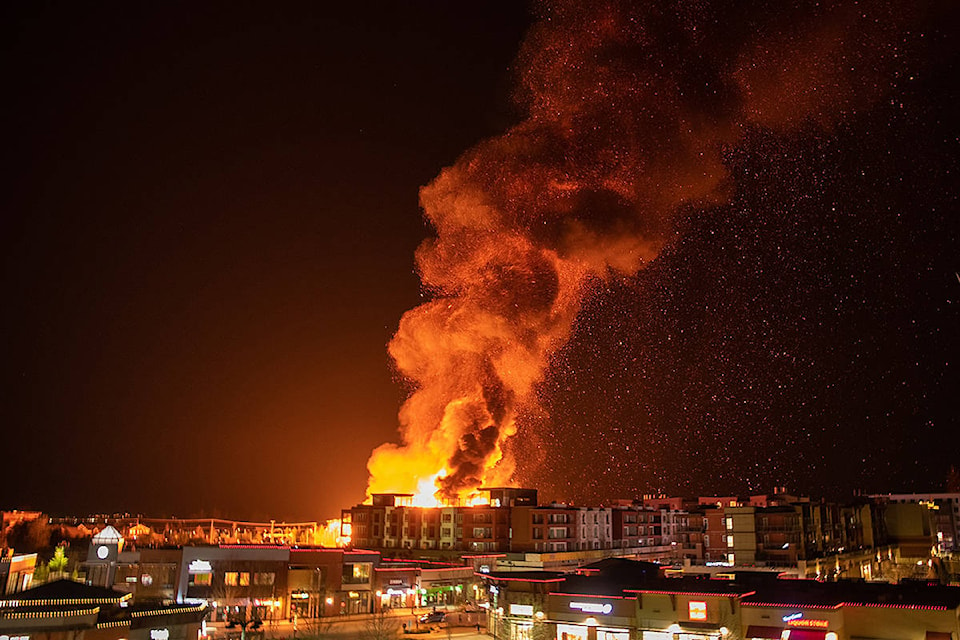A massive fire that tore through a condo complex in Willoughby in April didn’t impact just the developer and residents who were left dealing with the aftermath.
There was significant environmental impact to the Yorkson Creek.
The morning after the raging fire took hold of the under-construction Alexander Square condo complex on April 19 a volunteer with the Yorkson Watershed Enhancement Society (YWES) discovered the Yorkson Creek had been damaged by the blaze.
READ MORE: Willoughby Fire: The aftermath of the inferno in Langley
“The millions of gallons of chlorinated [municipal] water used for fire suppression from 10 p.m. Monday evening to 2 p.m. Tuesday the next day, entered nearby catch basins and storm sewers that flowed west two blocks and directly entered the Yorkson Creek at 80th Avenue,” explained Nat Cicuto, board chair of the Yorkson Watershed Enhancement Society.
Transported with the water was burn particulate and resins from melted asphalt shingles, dry wall, plastics, glass, and wood, he said.
Cicuto was the first on site on behalf of the YWES at 7 a.m. on April 20 to inspect the stream.
“I immediately noticed surface foam on the water, and some discolouration, and higher than expected stream flows,” he recalled.
Cicuto then took water samples from the south side and north side of the 80th Avenue culvert crossing.
“The south side was a very low stream flow, but very clear baseline water taken as a baseline sample of what the water quality should be on the north side of the crossing,” he explained. “I then took a water sample from the north side and transported both samples to the nearest [water testing lab] in Langley City.”
The results, Cicuto said, exceeded the ministry standard for chlorine. He called the chemical a “fish killer,” but admitted he didn’t immediately discover any dead.
Although harmful, this fire damage wasn’t the worst he’s seen.
In September 2018 a large bark mulch fire at Langley’s Cloverdale Fuel, a wood recycling and by-products company, burned for more than four days.
Cicuto recalls the environmental impact of that fire “horribly” worse.
“Millions of gallons of fire-contaminated, chlorinated, fire-suppression water entered the nearby Yorkson Creek and flowed north through Katzie Reserve 2 where it entered the Fraser River, and continued from there,” he explained.
Cicuto said that fire was when he learned that the Township of Langley Fire Department’s response is three tiered: first protect life, second protect property, third protect the environment.
Andy Hewitson, deputy chief with the Township of Langley, confirmed the tactical priorities.
“The Township has regulatory processes in place at all times to ensure our waterways are protected,” Hewitson said.
“As a member of the fire department this is not my area of expertise, however I have been advised that overall jurisdiction and related responsibilities associated with the protection of streams lies with the provincial government [Ministry of Forests, Lands and Natural Resource Operations] in conjunction with the federal government [Fisheries and Oceans Canada].”
However, a Township media spokesperson confirmed the chlorinated water to battle the Alexander Square fire was not treated before it entered the storm drains to Yorkson Creek.
“Crews and technical staff did inspect/monitor the receiving water course, and reported no damage to infrastructure or the environment,” the nameless individual said.
“However, as a result of this large fire, the Township will be developing a major fires protocol in consultation with the fire department.”
The protocol is expected to take up to six months to develop and implement. The Township said it will not include external consultation.
READ MORE: Fire at large woodpile fire at Langley’s Cloverdale Fuel still smouldering
It was after the Cloverdale Fuel fire that Cicuto said the society learned it needed to improve its response time and work more closely with planners, and decision makers with Fisheries and Oceans Canada, and local governments.
“There definitely is room for improvement of communication and bringing together more resources at critical times,” he admitted. “By the time the fire crews reach step three, they’re often tired having worked for 14 hours or five days straight in some cases. We need fresh crews to show up on site with step three in mind, after the site has been deemed safe to work safely around fire crews.”
The blaze in Willoughby on Monday, April 19 at 208th Street and 80th Avenue, first reported around 9:30 p.m. prompted a response from 76 firefighters, including additional support from City of Langley members.
Hewitson estimated millions of litres of water was used to battle the blaze.
“The underground parking area retained a very large quantity of the water used during operations and is currently being removed from site by contractors working for property management,” he said.
The Alexander Square apartment complex consisted of four buildings, each in various stages of construction, with two levels of concrete parkade and six levels of wood-frame construction, according to Metro-Can Construction, the general contractor for the site.
READ MORE: Langley condo fire cleanup may start soon
The total footprint of the four-building complex was 103,000 sq. ft. The complex had a total of 308 units, according to Laura Cropper, a media relations person with Metro-Can.
The cleanup for the condo fire was expected to begin May 10 and the developer pledged to keep affected owners informed.
Have a story tip? Email: joti.grewal@blackpress.ca
Like us on Facebook and follow us on Twitter.
